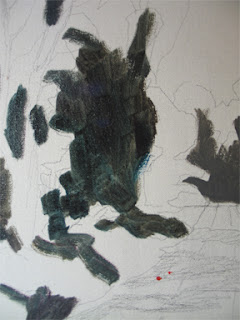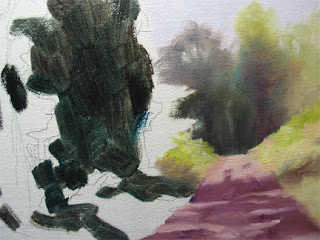 Starting a new painting. More acurately, two of the same painting. The following entries are some of the steps I made in the process. It was pretty easy to shoot a photo when I was swapping out the two paintings, using the same colors for each step on the two paintings. This is done with the limited palette I've been using lately from the book, The Yin/Yang of Painting, by Hongian Zhang, who gives three complementary palettes. Of these three: the blue-orange, the purple-yellow, and the red-green, I'm using the red-green palette colors. I'm not really missing the blues and the yellows much any more, since I have turquoise and citron to use.
Starting a new painting. More acurately, two of the same painting. The following entries are some of the steps I made in the process. It was pretty easy to shoot a photo when I was swapping out the two paintings, using the same colors for each step on the two paintings. This is done with the limited palette I've been using lately from the book, The Yin/Yang of Painting, by Hongian Zhang, who gives three complementary palettes. Of these three: the blue-orange, the purple-yellow, and the red-green, I'm using the red-green palette colors. I'm not really missing the blues and the yellows much any more, since I have turquoise and citron to use.I sketch out in pencil the basic shapes in the painting. Over this I spray workable fixative. Usually you would tone the canvas once the fixative is dry, but here I just didn't. I block in my darks, and then start carefully mixing my critical colors: the road colors. I paint of bit of my test color on a piece of scrap paper, and hold it right up to the photo. Then I talk to myself, warmer, lighter, more pink, more orange, more purple...til I get it right. The actual colors in the foliage don't matter quite so much, so long as you get the basic values right, but with the road and it's shadows, I want to come as close as I can.
I hope that you enjoy the following posts. The two finished paintings are posted today on my painting blog, Nel's Everyday Painting. The link is listed in the sidebar. Thanks for looking.






















